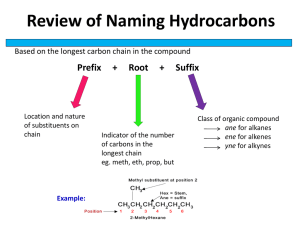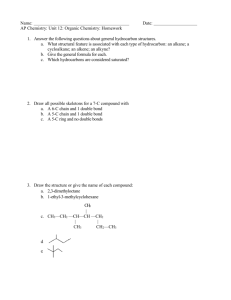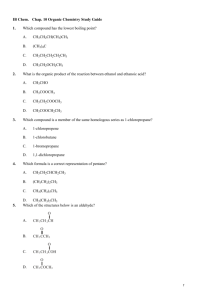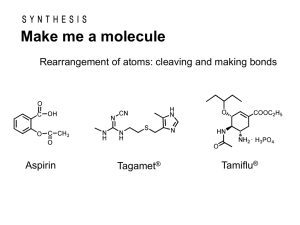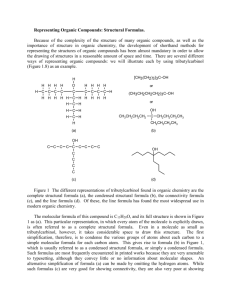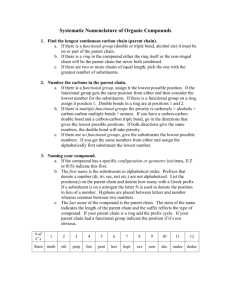Note - MsDunlop
advertisement
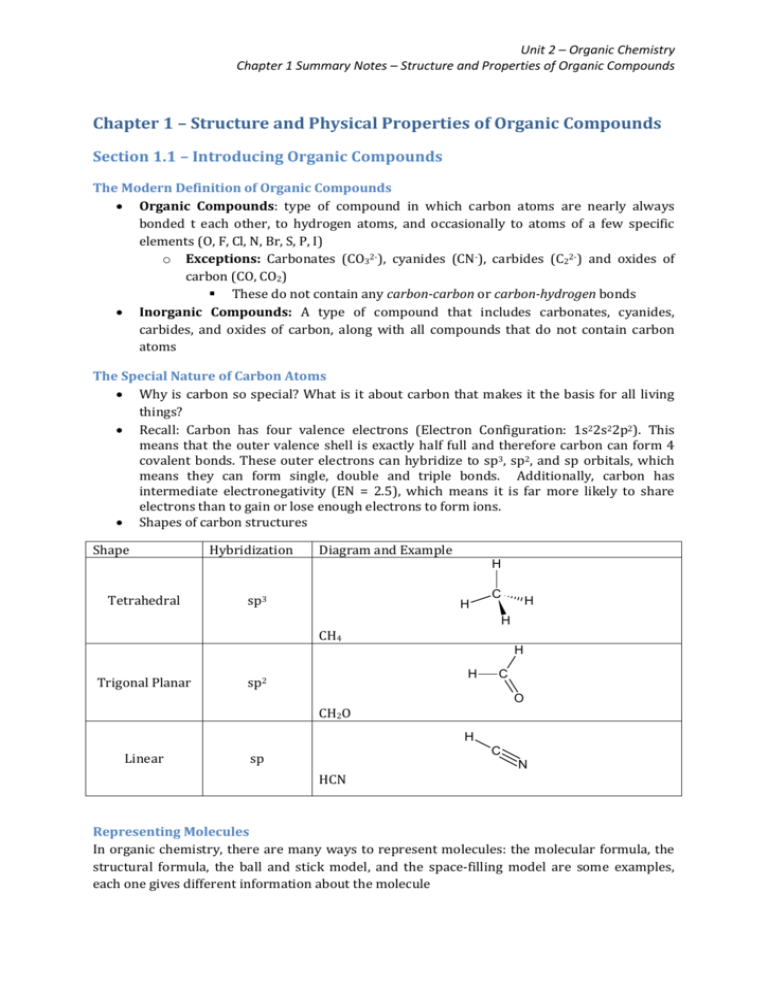
Unit 2 – Organic Chemistry Chapter 1 Summary Notes – Structure and Properties of Organic Compounds Chapter 1 – Structure and Physical Properties of Organic Compounds Section 1.1 – Introducing Organic Compounds The Modern Definition of Organic Compounds Organic Compounds: type of compound in which carbon atoms are nearly always bonded t each other, to hydrogen atoms, and occasionally to atoms of a few specific elements (O, F, Cl, N, Br, S, P, I) o Exceptions: Carbonates (CO32-), cyanides (CN-), carbides (C22-) and oxides of carbon (CO, CO2) These do not contain any carbon-carbon or carbon-hydrogen bonds Inorganic Compounds: A type of compound that includes carbonates, cyanides, carbides, and oxides of carbon, along with all compounds that do not contain carbon atoms The Special Nature of Carbon Atoms Why is carbon so special? What is it about carbon that makes it the basis for all living things? Recall: Carbon has four valence electrons (Electron Configuration: 1s22s22p2). This means that the outer valence shell is exactly half full and therefore carbon can form 4 covalent bonds. These outer electrons can hybridize to sp3, sp2, and sp orbitals, which means they can form single, double and triple bonds. Additionally, carbon has intermediate electronegativity (EN = 2.5), which means it is far more likely to share electrons than to gain or lose enough electrons to form ions. Shapes of carbon structures Shape Hybridization Diagram and Example H Tetrahedral sp3 H C H H CH4 H Trigonal Planar H sp2 C O CH2O H Linear C sp N HCN Representing Molecules In organic chemistry, there are many ways to represent molecules: the molecular formula, the structural formula, the ball and stick model, and the space-filling model are some examples, each one gives different information about the molecule Unit 2 – Organic Chemistry Chapter 1 Summary Notes – Structure and Properties of Organic Compounds For example: Ethane (C2H6) Molecular Formula C2H6 Structural Formula H H H C C H H Ball and Stick Model Space Filling H Additionally: Chemists often abbreviate structural diagrams, because organic molecules often contain a lot of hydrogen and carbon. Example: C4H10 H H H H H C C C C H H H H CH2 vs. H Structural Formula H3C CH3 CH2 vs. Condensed Structural Formula Line Structural Formula Each bend or end-point represents a carbon atom, it is assumed that there are enough hydrogens to complete the octet and form 4 bonds unless otherwise written. Isomers Carbon atoms can form bonds with each other, which often results in long straight or branched chains of atoms. Each carbon can also be boned to hydrogen or atoms of other elements. However, once you have enough carbons and hydrogen, the atoms can attach to each other in different ways; that is, they have the same molecular formula but they have a different structural formula For Example: Each of the following molecules has the formula C5H12 – they all contain 5 carbons and 10 hydrogens. H H H H C C C C H H H H H H H H H H C C C C C H H H H H H H H C H H H H C H H H H C H C C H H H C H H Each one of these molecules would have different physical properties, because the arrangement of the atoms is different Isomers: molecules that have the same molecular formula but their atoms are in different arrangements Constitutional Isomers: molecules that have the same molecular formula but their atoms are bonded together in different sequences (i.e. the examples above) Unit 2 – Organic Chemistry Chapter 1 Summary Notes – Structure and Properties of Organic Compounds Note: sometimes it is hard to tell if two molecules are isomers – remember, molecules are free to rotate, and individual atoms can rotate around a single bond. Consider the following: H H H H H C C C C H H C H H H H H H H H H C C C C H H H vs. H H H C H H These two molecules look structurally different, as drawn. BUT, they aresimply rotated 180, or flipped horizontally OR: H H H H H H C C C C C H H H H H H vs. H H C HH H H H C C C C H H H H H Because atoms can rotate around a single bond, these are the molecule and are not isomers of each other. Carbon atoms can also for ring structures with three or more atoms. For example, each of the following molecules is a constitutional isomer of the formula C5H10 H H H H C C C H H H H H C C H H H H H C C C C H H H H C H H H H H H C H H C C C H H C HH H H C H H C H C H H C H H C C H H H H H C H H C C C HH H Stereoisomers An important property of double bonds is that they ‘lock’ a structure in place: atoms cannot rotate around them. These make the molecule flat and rigid This leads to another type of isomer called a stereoisomer Stereoisomer: molecules that have the same molecular formula and their atoms are bonded together in the same sequence, but differ in the three-dimensional orientations of their atoms o There are two kinds of stereoisomers: enantiomers and diastereomers Diastereomers Diastereomers: stereoisomer based on a double bond, in which different types of atoms or groups are bonded to each carbon in the double bond H Unit 2 – Organic Chemistry Chapter 1 Summary Notes – Structure and Properties of Organic Compounds Example: C4H8, the molecules shown below contain a double bond between the second and third carbon H CH3 C H3C H3C C CH3 C H trans-2-butene C H H cis-2-butene The trans- isomer has the identical CH3 groups on opposite sides of the double bond, the cis- isomer has identical CH3 groups on the same side of the double bond. The groups do not have to be identical, as long as the larger groups are on the same side of the double bond, it is cis and if they are on different sides then it is trans The difference between cis- and trans- isomers is very important, especially in metabolic processes. Note: triple bonds do not form diastereomers Enantiomers Enantiomers: are non-superimposable mirror images of each other. They occur when a single carbon is bonded to four different types of atoms or groups Example: CHFClBr A more common example of enantiomers is your hands: they are perfect mirror images but you cannot superimpose them on each other. We even distinguish between different forms by conventions of right-handed or left-handed enantiomers Catch: these have IDENTICAL chemical properties, but are often metabolized differently, which makes this property incredibly important in pharmaceuticals and can be deadly if not taken in to account in synthesis processes o Example: Thalidomide Unit 2 – Organic Chemistry Chapter 1 Summary Notes – Structure and Properties of Organic Compounds Section 1.2 – Hydrocarbons Hydrocarbons: organic compounds that contain only carbon atoms and hydrogen atoms o Example: fossil fuels such as natural gas and gasoline Alkanes Alkane: the simplest hydrocarbon in which all carbon atoms are joined together by single covalent bonds o Also called Saturated Hydrocarbons: hydrocarbons that contain only single bonds, no double or triple bonds, that is, each carbon atom is bonded to the maximum possible atoms and all of them are sp3 hybridized The simplest alkane is methane (CH4) and each additional alkane adds either a CH2 or CH3 to the chain The general formula for a straight or branched alkane is CnH2n+2 o Therefore: if you have an alkane with 5 Carbons: C5H2×5+2 = C5H12 H H C H H3C H Methane CH3 H3C Ethane CH2 CH2 CH3 Propane H3C CH3 CH2 Butane Alkanes can also have substituent groups, where an atom or groups of atoms has been substituted in place of a hydrogen, often called a side group Naming Alkanes The International Union of Pure and Applied Chemistry (IUPAC) has a system for naming organic compounds. Each organic compound name has the following components: Root: denotes the number of carbon atoms in the longest continuous chain of carbon atoms Prefix: gives the positions and names of any branches from the main chain Suffix: indicates the series to which the molecule belongs. The suffix for alkanes is ‘-ane’ Alkyl Groups: a side group based on an alkane; to name them you use the same root as the main chain, but instead of the suffix ‘-ane’ you use ‘-yl’ Number of Carbon Atoms 1 2 3 4 5 Root Name Side Group Name methethpropbutpent- methylethylpropbutpent- Number of Carbon Atoms 6 7 8 9 10 Root Name Side Group Name hexheptoctnondec- hexyl heptyl octyl nonyl decyl Unit 2 – Organic Chemistry Chapter 1 Summary Notes – Structure and Properties of Organic Compounds Steps for Naming Alkanes Name the following compound: CH3 CH2 CH3 CH2 C HC H3C CH3 CH2 CH3 CH3 1. Identify Root CH2 CH3 a. Identify the longest continuous carbon CH2 C HC chain b. Find the root for the number of H C CH2 CH3 3 CH3 carbons in the chain 2. 3. a. b. c. d. e. f. 4. The longest chain is six carbon atoms, therefore the root is hexIdentify the Suffix The compound is an alkane, therefore the suffix is ‘-ane’ Identify the Prefix a. Two side groups have one C atom, the The prefix indicates the position and other has two CH3 type of side groups on the main chain. CH2 CH3 To identity the prefix: CH2 C HC Identify the number of carbon atoms in each side group H3C CH2 CH3 CH3 Determine the number of each side group according to the number of b. The side groups with one carbon atom carbons are methyl groups, the other side group If there is more than one side group, is an ethyl group. write their names in alphabetical order c. Alphabetical order: ethyl, methyl Find the position of each side group. d. Numbering must begin at the end of CH3 CH2 CH3 the chain that gives the lowest possible 5 6 numbers. CH2 C HC Precede the name of each side group 2 3 4 with the number of carbon atoms to H3C CH2 CH3 CH3 1 which it is attached on the main chain. Use a hyphen to separate numbers and words, and use a comma to separate The compound is numbered from left to right. This gives the side numbers 3, 3, 4. The two the numbers Use a prefix to indicate how many of methyls are on C-3, and ethyl is on C-4. e. The prefix is now: 4-ethyl-3,3-methyl each type of side group there are if f. The two methyl groups make the there is more than one of the same prefix: 4-ethyl-3,3-dimethylgroup: di, tri, tetra, penta. These additional prefixes do not affect the alphabetical order established before Name the Compound 4-ethyl-3,3-dimethylhexane Combine the prefix, root, and suffix. Note: no space, dash, or comma between prefix, root, and suffix Unit 2 – Organic Chemistry Chapter 1 Summary Notes – Structure and Properties of Organic Compounds Practice 1: Name the following alkanes a. b. (answer: 2,3,4-trimethylpentane) (answer: 4,5-diethyl-3,6-dimethyloctane) Drawing Alkanes Example: Draw the line structural formula for 3-ethyl-3-methylpentane 1. Identify the root The root is pent- so there are five carbons in The root of the name gives the number of the main chain carbon atoms in the main chain 2. Identify the suffix The suffix is –ane, so the compound contains only single bonds 3. Draw and number the main chain, but do not add any hydrogen atoms C—C—C—C—C yet 4. Identify the prefix and draw the side The prefix is 3-ethyl-3-methyl-. Therefore, groups there is an ethyl group and a methyl group attached to carbon atoms 3 of the main chain. You can place the side groups on either side of the main chain CH3 5. Complete the condensed structural formula H3C CH2 C CH2 CH3 CH2 CH3 6. Draw the line structural formula Practice 2: Draw the line and condensed structures for the following molecules: a. 3-ethyl-2-methylheptane b. 2,3,3,-triethylpentane Physical Properties of Alkanes Non-polar, therefore not soluble in water; but soluble in non-polar solvents like benzene Low carbon alkanes (1-4) are gases at room temperature, medium length alkanes are liquids; long length (over 26) are solid at room temperature; property is due to increasing number of London Dispersion Forces Unit 2 – Organic Chemistry Chapter 1 Summary Notes – Structure and Properties of Organic Compounds Alkenes Alkenes are any hydrocarbon that has at least one double bond in the carbon chain o When a carbon has one double bond it is sp2 hybridized; when it has two double bonds it is sp hybridized Unsaturated hydrocarbons: hydrocarbons that contain a double or triple bonds, whose carbon atoms can potential bond to additional atoms if those bonds are broken. When naming alkenes you must include the location of all the double bonds, the carbon indicated is the lower numbered carbon The suffix for alkenes is ‘-ene’ Remember: double bonds can result in diastereomers if different side groups are present Examples: H H H C H H H H H C H C H H Ethene H C H C C C H H H H C C C H H C H H C H Propene H C H H H 1-butene 1-butene H H H H C C H H C C H H H H Trans-2-butene C H C H C HH C H H cis-2-butene Note: cis-double bonds form kinks in long carbon chains (important for later) Properties of Alkenes Non-polar, therefore do not dissolve in water; dissolve in non-polar solvents (like benzene) Boiling points increase as more carbons are added However: alkenes have lower boiling points than alkanes of similar carbon lengths Slight difference in location and shape around the double bond change the boiling points o But-1-ene = -6.3C o Trans-but-2-ene = 0.88C o Cis-but-2-ene = 3.71C Naming Alkenes: The process is the exact same as naming alkanes, except the suffix is –ene; if there is more than one double bond, you must use ‘di’, ‘tri’, etc. to indicate the number, just as with alkyl prefixes Unit 2 – Organic Chemistry Chapter 1 Summary Notes – Structure and Properties of Organic Compounds Example: Name the following alkene H3C H3C CH3 C CH HC CH3 1. Identify the root a. Identify the longest chain that CONTAINS THE DOUBLE BOND(S) b. Find the root for the number of carbons in the chain. H3C H3C CH3 C HC CH CH3 The longest containing the double bond is five carbons, therefore the root is pent- 2. Identify the suffix a. Number the main chain by starting at the end of the chain nearest the double bond, giving the double bond the lowest numbers possible (Note: this takes precedence over any rule for numbering alkanes) b. If the alkene contains four or more carbons, you must give the position in the suffix. 3. Identify the prefix Name the side groups on alkenes as you would for alkanes H3C H3C 1 CH3 C CH 3 HC 5 4 2 CH3 Numbering from left to right gives the lowest possible carbon numbers The compound is an alkene. It contains four or more carbons. The double bond is between C2 and C-3. The suffix is -2-ene H3C H3C 1 CH3 C CH 2 3 HC 5 4 CH3 There are two methyl groups, one on C3, the other on C4. The prefix is 3,4-dimethyl4. Name the compound 3,4-dimethylpent-2-ene Practice: a. b. 5-ethyl-3,4,5-trimethyloct-3-ene 3-ethyl-4-methylhex-2,4-diene Practice: Draw the line structural diagram of 3-ethyl-4-methylhex-3-ene Unit 2 – Organic Chemistry Chapter 1 Summary Notes – Structure and Properties of Organic Compounds Alkynes Alkynes are hydrocarbon that contain one or more triple bonds, these are also unsaturated hydrocarbons General Structural Formula: CnH2n-2 Note: the presence of triple bonds means both carbons are sp hybridized, therefore the structure is linear Triple bonds do not cause stereoisomers Examples: HC HC C HC ethyne H3C CH3 CH propyne C C C CH3 but-1-yne CH2 CH3 but-2-yne Naming and Drawing Alkynes Example: Name the following alkyne H3C C CH CH H2C CH3 1. Identify the root The longest chain that includes the triple bond a. Identify the longest chain that is five carbon atoms, so pent- is the root CONTAINS THE TRIPLE BOND(S) c. Find the root for the number of carbons in the chain. 2. Identify the suffix Numbering starts at the end that gives the a. Number the main chain by starting at triple bond the lowest number, in this case Cthe end of the chain nearest the triple 1, the compound contains a triple bond. C bond, giving the triple bond the lowest H3C CH 2 CH numbers possible 1 3 (Note: this takes precedence over any H2C 4 CH rule for numbering alkanes, and takes 3 5 precedence over double bonds) b. If the alkyne contains four or more The suffix is -1-yne carbons, you must give the position in the suffix. 3. Identify the prefix There is a methyl group on C-3 Name the side groups on alkynes as The prefix is 3-methylyou would for alkynes 4. Name the compound 3-methylpent-1-yne Example: draw the following alkyne: 4-ethylhex-2-yne H3C CH2 CH C C CH3 H2C CH3 Physical Properties: Have higher MP/BP then analogous alkenes and alkanes Unit 2 – Organic Chemistry Chapter 1 Summary Notes – Structure and Properties of Organic Compounds Cyclic Hydrocarbons Cyclic Hydrocarbons are hydrocarbons that form rings These are the foundation of many biological molecules, including cholesterol and the steroid hormones. Can be alkanes, alkenes, or alkynes (but alkyne-based rings are extremely unstable) The prefix ‘cyclo’ is added to indicate it Examples: CH2 H2C CH2 Cyclopropane H2C CH2 H2C CH2 Cyclobutane H2C CH2 CH2 CH2 CH 2 H2C CH2 CH2 H2C CH2 CH2 Cyclopentane Cyclohexane Naming Cyclic Hydrocarbons Example: CH3 H3C 1. Identify the root Determine the root of carbon atoms in the ring in order to find the root. This is the same as the straight chain alkane, alkene, or alkyne with the same number of carbon atoms, preceded by cyclo2. Identify the suffix Determine whether the molecule has all single bonds, at least one double bond, or at least one triple bond. The suffix is –ane, -ene, or –yne accordingly. It is not necessary to indicate the location of the double or triple bond, because they are assumed to be on C-1 3. Identify the prefix Note: if there are no side groups, then it is not necessary to indicate the position of the side groups; however if there are, then the double or triple bond must be between C-1 and C-2, numbering must go according to that 4. Name the compound There are five carbon in the ring, therefore cyclopent- is the root The ring has one double bond, therefore the suffix is -ene CH3 H3C 3 4 5 2 1 The prefix is 3,4-dimethyl3,4-dimethylcyclopentane Physical Properties: MP/BP are slightly higher than analogous straight chain hydrocarbons Unit 2 – Organic Chemistry Chapter 1 Summary Notes – Structure and Properties of Organic Compounds Aromatic Hydrocarbons Benzene: a cyclic aromatic hydrocarbon, C6H6, in which all six carbon-carbon bonds are intermediate in length between a single and double bond; results from delocalized electrons in sp2 hybridized orbitals (unhybridized p-orbitals form the delocalized pelectrons) o Results from the resonance structures formed o Unusually stable NOTE: because of the sp2 hybridization, benzene rings are FLAT H H H C C C C C H C H H Structural Diagram Alternating resonance forms Resonance hybrid Showing delocalized e- Aromatic Hydrocarbons: compound that contains only carbon and hydrogen and based on the structure of benzene Aliphatic hydrocarbon: compound containing only carbon and hydrogen in which carbon atoms form chains and/or non-aromatic rings Naming and Drawing Aromatic Hydrocarbons Note: the root for ALL aromatic hydrocarbons is benzene CH3 H3C 1. Identify the root The root is -benzene 2. Identify the prefix a. Determine the position number of the side groups in order to write the prefix. The carbons in a benzene ring are numbered if there is more than one side group b. Prioritize alkyl groups with six or fewer carbons in alphabetical order. Then continue to number in the direction of the nearest side group c. Write the prefix as you would for any other hydrocarbon 3. Name the compound CH3 CH2 -benzene CH3 CH3 2 H3C CH2 3 1 4 6 5 There are two methyl groups and one ethyl group. Numbering is counterclockwise to give the lowest numbers. 1-ethyl-2,3-dimethyl1-ethyl-2,3-dimethylbenzene If a benzene ring is present as a side group off an alkyl chain, then it is called a phenyl group Unit 2 – Organic Chemistry Chapter 1 Summary Notes – Structure and Properties of Organic Compounds Example: Name the following compound H3C CH2 CH CH3 CH2 CH2 CH2 (answer: 3-phenylheptane) Physical Properties of Aromatics: Benzene is a liquid at room temperature, and is a common solvent for non-polar compounds Often have very similar MP/BP to aliphatic compounds with the same number of carbons These compounds often have strong odours Section 1.2 – Hydrocarbons, Summary Unit 2 – Organic Chemistry Chapter 1 Summary Notes – Structure and Properties of Organic Compounds Section 1.3 – Hydrocarbon Derivatives Organic compounds are classified according to their functional groups Functional gropu: in a molecule, a certain gropu of atoms responsible for chemical reactions that are characteristic of the molecule o Responsible for chemical and physical properties of the molecules o Change the suffix or the prefix of the compound Hydrocarbon Derivative: a a compound made up of carbon atoms and at least one other atom that is not hydrogen Functional Group and the Suffix/Prefixes Organic Compound Alcohol Haloalkane General Formula For Functional Group R OH Hydroxyl group R X (X=halogen) Prefix or Suffix -ol Prefix varies with halogen F = fluoro; Cl = chloro; Br = bromo; I = iodo O Aldehyde C R -al H (formyl group) O Ketone C R -one R' (carbonyl group) O C Carboxylic Acid R -oic acid OH (carboxyl group) O C Ester H R -oate O (carboxyl group) O Ether R' -oxy; -yl R (alkoxy group) R' N Amine R R'' -amine (amine group) O C Amide R R' N -amide R'' (amide group) Note: R, R’, and R’’ can represent either a hydrogen or unspecified hydrocarbon chains Unit 2 – Organic Chemistry Chapter 1 Summary Notes – Structure and Properties of Organic Compounds Alcohols

